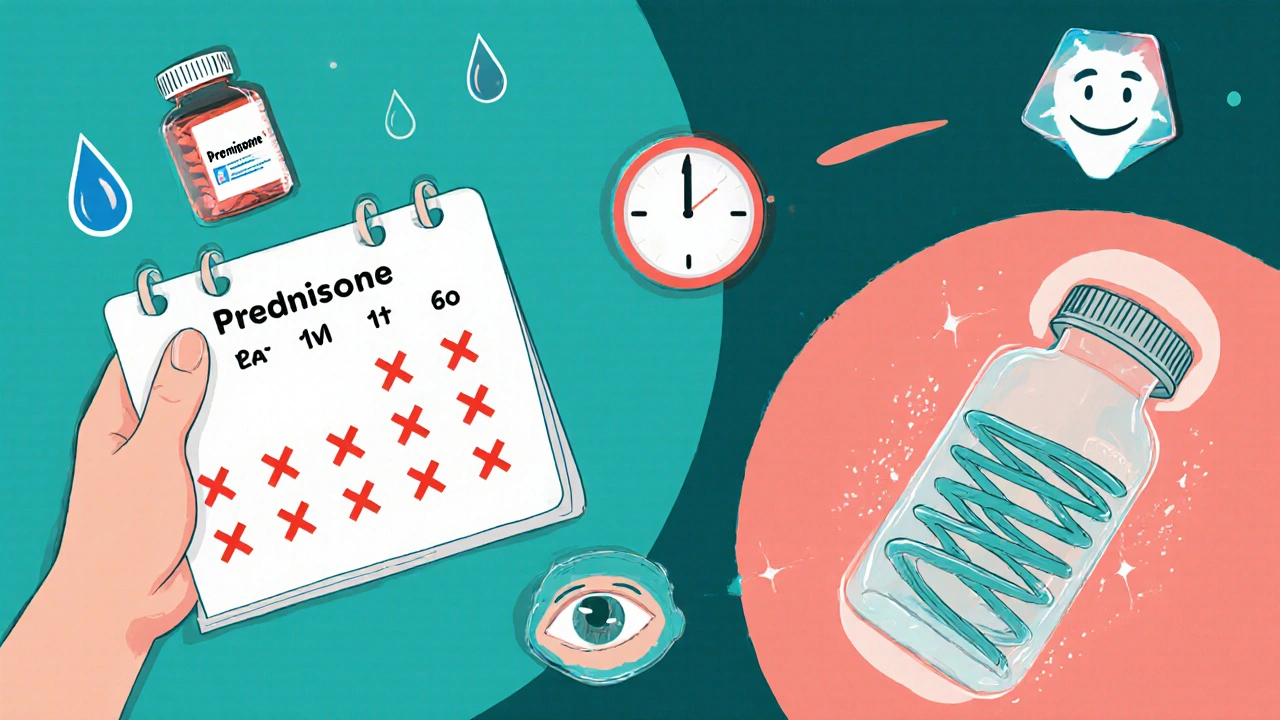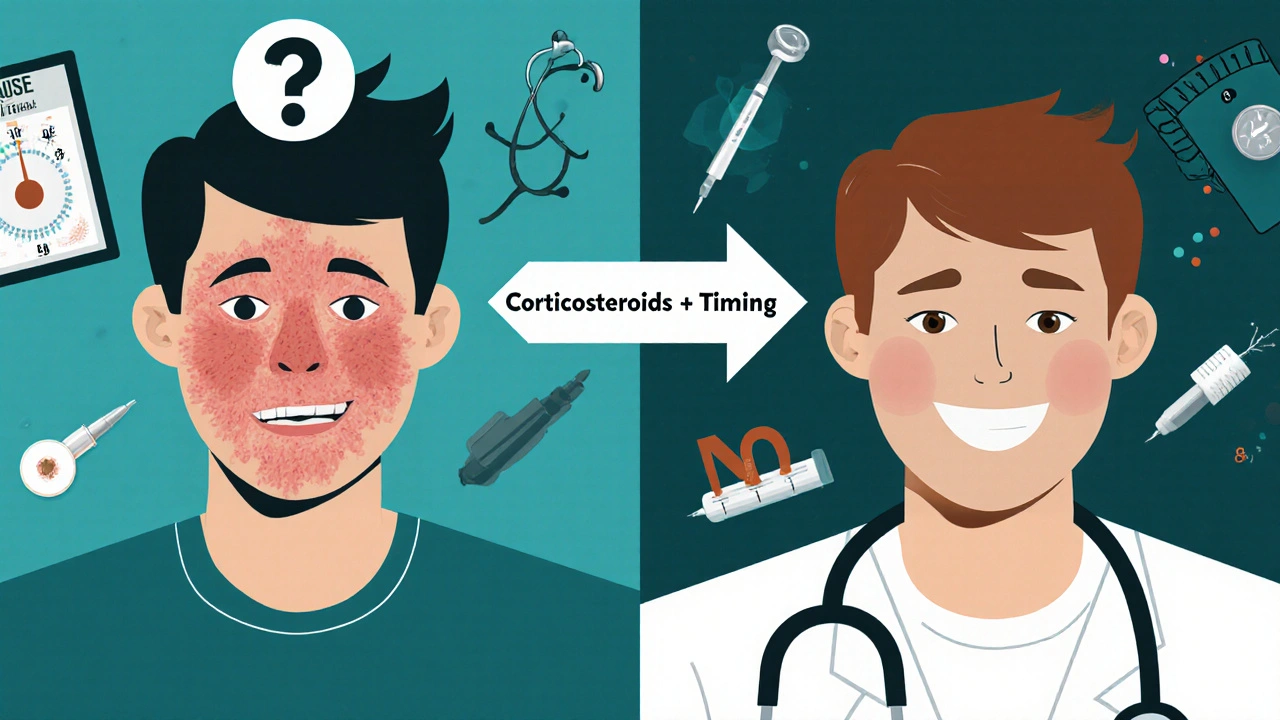What Is Bell’s Palsy?
Bel’s palsy is sudden, one-sided facial weakness or paralysis that happens without warning. It’s not a stroke, not a tumor, and not caused by an injury. It’s the result of inflammation and swelling of the facial nerve - the seventh cranial nerve - as it passes through a narrow bony tunnel in the skull. When that nerve gets squeezed, it can’t send signals properly to the muscles on one side of your face. You might notice your eye won’t close, your smile looks crooked, or food keeps falling out of your mouth. Symptoms usually peak within 48 hours and can be terrifying, especially if you’ve never heard of it before.
It affects about 1 in 5,000 people each year. Most cases happen between ages 15 and 45, but it can strike anyone. Pregnant women, people with diabetes, and those with upper respiratory infections are at slightly higher risk. The good news? Most people recover fully - but only if they get the right treatment quickly.
Why Corticosteroids Are the First-Line Treatment
For decades, doctors tried everything: acupuncture, herbal remedies, electrical stimulation. But the only treatment with strong, consistent evidence is corticosteroids - specifically, oral prednisone. A 2019 Cochrane review of 895 patients across seven randomized trials found that corticosteroids cut the chance of incomplete recovery by over 30%. That’s not small. That’s life-changing.
Here’s how it works: when the facial nerve swells inside its bony canal, it gets crushed. Think of it like a garden hose pinched between two rocks - water can’t flow. Corticosteroids don’t fix the virus (if one is involved), but they calm the inflammation. Less swelling means less pressure on the nerve. That gives the nerve a chance to heal properly.
According to the American Academy of Family Physicians (AAFP), the standard dose is 50 to 60 mg of prednisone daily for five days, then a five-day taper down to zero. Total dose: 500 mg. Studies show that doses under 450 mg lead to worse outcomes - 30% of patients don’t recover fully. At 450 mg or more, that drops to just 14%. The difference isn’t subtle. It’s the line between a full smile and a permanent droop.
Timing Is Everything - The 48-Hour Window
Starting treatment early isn’t just helpful - it’s critical. The Cochrane review and AAFP both confirm that the best results come when corticosteroids are started within 48 hours of symptoms appearing. After 72 hours, the benefit drops sharply. That’s why many people who wait to see if it gets better end up with lasting problems.
Real-world data shows patients often delay care. The average time to diagnosis is 3.2 days. Why? Because Bell’s palsy mimics stroke. People panic, go to the ER, get scanned, and wait. But unlike stroke, Bell’s palsy doesn’t show up on CT or MRI. A doctor who knows what to look for - facial droop without weakness in the rest of the body - can diagnose it in minutes. If you wake up with one side of your face numb or drooping, don’t wait. Call your doctor. Go to an urgent care clinic. Don’t assume it’s just a bad night’s sleep.
Corticosteroids vs. Antivirals: What Actually Works?
You might have heard that antivirals like acyclovir or valacyclovir help with Bell’s palsy. That’s a common myth. The evidence doesn’t support using antivirals alone. The AAFP says there’s no high-quality proof they help by themselves. They don’t improve recovery rates compared to placebo.
But here’s the twist: when corticosteroids are combined with antivirals, there’s a small but meaningful benefit - not for full recovery, but for preventing long-term complications like synkinesis. That’s when your face muscles move in the wrong way - you blink and your mouth pulls up, or you smile and your eye squeezes shut. It’s awkward, sometimes painful, and hard to fix. The Cochrane review found combination therapy reduced synkinesis risk by 33%. For people with severe paralysis (House-Brackmann grade IV or higher), many doctors now recommend the combo. But for mild to moderate cases? Corticosteroids alone are enough.

Side Effects: What to Expect
People hear “steroid” and think weight gain, diabetes, osteoporosis. Those are risks with months or years of use. Not with a 10-day course. The Cochrane review tracked 715 patients on prednisone and found no serious side effects. The most common complaints? Trouble sleeping, increased appetite, and mood swings - all temporary. One study noted three people had sleep disturbances. That’s it.
Diabetics need to monitor blood sugar closely during treatment. Prednisone can spike glucose levels, even in people without diabetes. Most cases return to normal within days of stopping the pill. Patients who are worried about side effects often skip doses or stop early. That’s dangerous. Non-adherence happens in about 12% of cases - and those patients are more likely to have incomplete recovery. Stick to the schedule. Even if you feel better after three days, finish the taper.
What Doesn’t Work - And Why
There’s a lot of noise out there. You’ll see ads for laser therapy, hyperbaric oxygen chambers, acupuncture, or injections into the ear. Some clinics even offer stellate ganglion blocks. The AAFP reviewed 32 to 35 studies on these alternatives. None showed high-quality evidence they’re better than corticosteroids. Some had tiny sample sizes. Others had no control groups. A few showed minor improvements, but nothing consistent enough to change guidelines.
And while it’s tempting to try something “natural,” there’s no herb, supplement, or essential oil proven to speed up nerve recovery. The facial nerve heals through reduced inflammation and time - not magic. Don’t waste money or delay real treatment chasing unproven options.
Recovery: What to Expect Over Time
Even without treatment, about 70% of people recover fully within three months. With corticosteroids, that jumps to 85% or higher. Machine learning studies of nearly 500 patients show 72.6% recovery at three months and 89.5% by nine months with proper treatment. Age is the biggest predictor - people under 50 recover faster. But corticosteroid use is the second strongest factor. That’s huge.
Recovery isn’t always linear. You might wake up one day and your eye closes better. Then, a week later, your smile feels stiffer. That’s normal. Nerve regeneration is messy. Most people see steady improvement over weeks, not days. The House-Brackmann scale - used by 92% of neurology clinics - helps track progress. It grades facial movement from I (normal) to VI (complete paralysis). Doctors use it to decide if you’re on track or need extra help.

When to See a Specialist
If your symptoms aren’t improving after three weeks, or if you develop pain behind the ear, blisters on the ear or tongue, or weakness in other parts of your body, you need to see a neurologist or ENT. That could mean Ramsay Hunt syndrome (caused by the shingles virus), Lyme disease, or something more serious. Bell’s palsy is a diagnosis of exclusion - meaning you rule out other causes first.
Also, if you’ve had Bell’s palsy before, don’t assume it’s the same. Recurrent cases need more testing. There’s a small link between Bell’s palsy and autoimmune conditions or tumors. Don’t panic - most are still idiopathic - but don’t ignore red flags.
What You Can Do Now
- If you have sudden facial weakness, don’t wait. Seek care within 48 hours.
- Ask your doctor for oral prednisone - 50-60 mg daily for five days, then taper.
- Don’t stop early. Even if you feel better, finish the course.
- Protect your eye. Use artificial tears and tape your eyelid shut at night.
- Track your progress. Take a photo every few days. It helps you and your doctor see improvement.
- If you’re diabetic, check your blood sugar daily. It will likely rise.
Final Thought
Bell’s palsy is scary, but it’s not dangerous. It’s not life-threatening. And with the right treatment, most people get their face back. The science is clear: corticosteroids work. Timing matters. Dose matters. Adherence matters. You don’t need expensive gadgets or exotic therapies. You need a doctor who knows the evidence - and the courage to start treatment fast.
Is Bell’s palsy the same as a stroke?
No. A stroke affects the brain and often causes weakness in the arm or leg on the same side as the facial droop. Bell’s palsy only affects the face. If you have facial weakness along with arm or leg weakness, confusion, trouble speaking, or loss of balance, call emergency services immediately - it could be a stroke.
Can Bell’s palsy come back?
Yes, but it’s rare - about 10% of people experience a second episode. If it happens again, especially on the same side, your doctor should investigate for underlying causes like Lyme disease, sarcoidosis, or autoimmune conditions. Recurrent Bell’s palsy isn’t normal and needs further testing.
Do I need an MRI or CT scan for Bell’s palsy?
Usually not. Doctors diagnose Bell’s palsy based on symptoms and a physical exam. Scans are only ordered if the diagnosis is unclear - for example, if weakness is on both sides, if it’s getting worse after a week, or if you have other neurological symptoms. Most cases don’t need imaging.
How long does it take to recover from Bell’s palsy?
Most people start seeing improvement within two to three weeks. Full recovery usually takes three to six months. With corticosteroids, recovery is faster and more complete. A small number - about 10% - have lasting weakness or abnormal movements (synkinesis), especially if treatment was delayed.
Can children get Bell’s palsy?
Yes. Children can develop Bell’s palsy, though it’s less common than in adults. The same corticosteroid treatment is used, but dosing is based on weight. There’s less research on kids, so doctors may be more cautious. Always consult a pediatrician or pediatric neurologist for treatment in children.
Are there any long-term side effects from taking prednisone for 10 days?
No. Short-term use - 10 to 14 days - doesn’t cause osteoporosis, cataracts, or adrenal suppression. Any side effects like sleep trouble, increased hunger, or mood changes go away once you stop the medication. The risk of serious side effects is extremely low at this dose and duration.
Should I avoid sunlight or get a tan while on prednisone?
Prednisone doesn’t make your skin more sensitive to UV light. You don’t need to avoid the sun. But if you’re feeling fatigued or have a weakened immune system (which can happen with illness), it’s smart to protect your skin anyway. Use sunscreen and stay hydrated.
Can I drive or work with Bell’s palsy?
Most people can, but it depends on symptoms. If your eye won’t close, you may have blurred vision or sensitivity to light. If you can’t control your mouth, eating or speaking might be hard. Use eye protection, take breaks, and don’t drive if you feel unsafe. Many people return to work quickly once treatment starts and symptoms improve.

Comments (15)